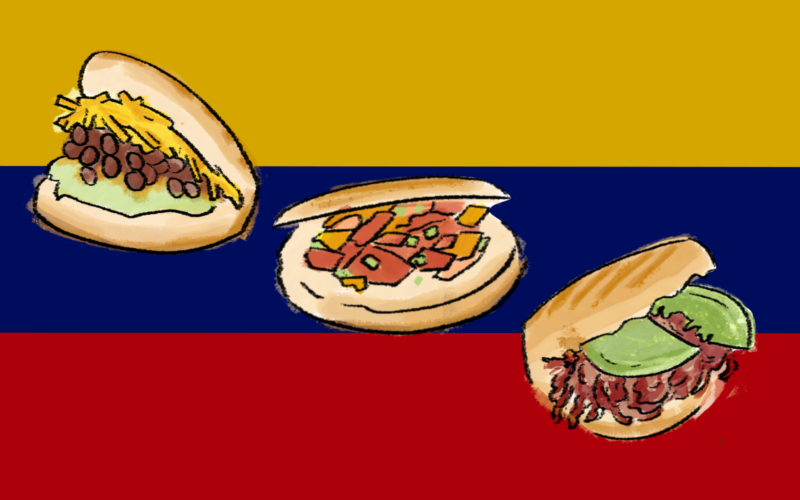Can the arepa do for Venezuela what the taco did for Mexico?
It was quite the moment, seeing an arepa on the big screen as depicted in Disney’s Encanto. It made my eyes water. It was such an important moment for me, especially as a Venezuelan woman with Colombian ancestry. Seeing an arepa with queso in a character’s hand validated my experience and belief that all Latin American cuisines deserve to be in the spotlight, explored and tasted by all.
It’s quite interesting that food references have had to widen their perspectives from a French and European focus, but the arepa’s popularity has been blooming in the North American media. We see this with Encanto, where Colombian arepas and characters are at the centre of the story.
As an introduction to solid foods, Venezuelan babies are fed the inner fluffy dough of the arepa, making it an essential part of growing up Venezuelan. My parents weren’t any exception in raising me with an intense love for arepas.
It’s quite common to see children bring arepas wrapped in napkins or aluminum foil in their lunchboxes. I often brought an arepa for lunch in my elementary school days, which continued into high school and even CEGEP and university. Other kids were shocked at what I was holding in my hands. Since the gesture of holding it reminded them of a sandwich, the interest would soon fade. “It’s just a sandwich,” they’d all say.
It’s much more than Venezuela’s bread; it’s such an important part of the collective Venezuelan gastronomic conscience. The arepa represents venezolanidad — it’s at the core of a Venezuelan’s DNA and identity. It’s a food that creates an identity and immediate connection. Even when outside of their motherland, Venezuelans are drawn to the arepa. I am, personally! My family buys corn flour weekly and enjoys arepas often.
The arepa is a round, mostly flat, corn maize split in the middle and eaten like a sandwich, with any topping you like. It’s a staple meal for Venezuelans, as it has been eaten for centuries. The arepa is vegan and gluten-free. In Quebec, 13 per cent of the population is Latin American, but despite that, there aren’t many places where the arepa is celebrated.
Why is the arepa, despite being such a versatile and healthy meal, so underrated? It doesn’t make any sense at all! The arepa has been loved and eaten by millions of Venezuelans for centuries, including me. It deserves to have its own spotlight and be appreciated for its own history and flexibility.
While Mexican cuisine remains popular in North America, I’m hopeful and optimistic that this will change in the years to come. I’m sick of people only associating Latin America with Mexican cuisine. Ignoring the fact that Latin America is filled with vibrant, colourful dishes that deserve every ounce of appreciation is wrong. It’s time to celebrate all of Latin America, not just a select few countries!
Let’s make the arepa global, especially since it can accommodate most diets.
It’s hard not to fall in love with what the arepa represents. It’s a small portion of pre-colonization that has outlived Venezuela’s ever-changing society. Of course, the arepa has been modernized with the invention of the tostiarepa, an arepa maker, and the corn flour that has aided in making the preparation process much easier than with maize grains. Its core ingredient, maize, has not changed in the slightest.
The name arepa comes from “erepa,” which originates from the Indigenous tongue of Cumanagoto. Erepa simply means corn, showing just the humility and simplicity of what the arepa has always been. The arepa is also one of the manifestations of the importance of corn in many Latin American gastronomies.
It’s much more than what may seem a one-dimensional, one-time item. In fact, any ingredient can be used as filling, from chicken, avocado to braised beef and cheese. There’s no wrong answer when it comes to arepa — the sky’s the limit!
Although it may look simplistic in its preparation and presentation, reminding many of another iteration of a sandwich, the arepa has filled dining tables at sunrise, midday and after sunset.
As a Venezuelan woman who has lived in Montreal since she was seven, I’m pretty sure that at least one of my DNA strands is made out of fluffy, inner-arepa dough. The arepa has such a big significance for Venezuela, showing its multicultural idiosyncrasies.
It highlights the impact of not only the Spaniard Conquistadors or the African Slaves who left their mark on Venezuelan cuisine, but also the country’s first inhabitants. It’s also a representation of the inclusion of the many immigrants that Venezuela welcomed during its days of glory.
What’s intriguing about arepas in other countries is how they put their own twists on the ingredients. It becomes much more than a food item; it turns into an experience. It’s interesting to note that areperas (arepa-only restaurants) weren’t being gatekept by Venezuelans and were enjoyed by many, as they welcomed migrants from all over the world.
An important facet of globalizing the arepa is through areperas that have popped up all around the world. The importance of Venezuelan restaurants and areperas outside of Venezuela can be the key to a smooth transition in immigrating from one side of the world to another. In Montreal, we have such places where we can sense a beautiful blend of Spanish and French in the air, being reminded of the beauty and importance of embracing Montreal as a home to multiculturalism.
I firmly believe that the arepa will help Venezuela be even more known and beloved by the masses. The future is as bright as the inner, white fluffy dough of the arepa and can take any shape like its endless list of fillings.




